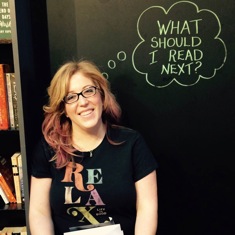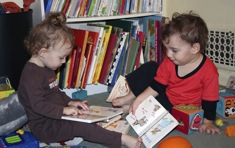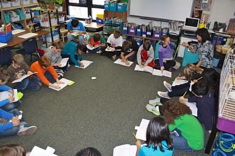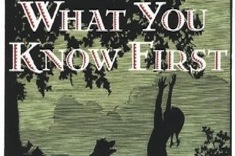For nine of the ten years I’ve been teaching, I’ve been in a classroom with eighth graders. Part of what I love so much about this age group is that it truly is a transitional time. Looking back on their childhood, having made it through early adolescence relatively unscathed (we hope), and looking ahead to their teen years is a time of worry, excitement, nervousness, and anticipation.
By the end of the year in eighth grade, with high school looming on the horizon, it’s also a time when I hope my students can reflect on what has gotten them to this point, and recognize the tools they have to help them be successful in high school. It’s a time when I hope they won’t forget who they are at their core, as they need strength of character to make good choices and stay on the right path when they leave our school and head to high school.
Each year as I look at closing out the year with my students, I continue to come back to the poem “Where I’m From,” by George Ella Lyon. I could see this poem working just as well at any grade level when students will be leaving a school building to go to a new one for the next year as a way to close out the year with reflection.
Ever since I learned about the “Where I’m From” poem when I was asked to complete one in a class for my master’s program, I knew it was one I was going to want to use with my students. In eight years of using it in my classroom, it has become my favorite writing activity I have students work on. Their writing with this poem is powerful and has had the most lasting effect on me as a teacher, because I see my students in a new way and help them see themselves and what makes them who they are more clearly.
I am from where saying daddy isn’t in my vocabulary anymore because he’s never around . . .
I am from I have 4 dads: the one that was there when I was growing up as a baby, the one that donated his DNA, my godfather, the one that came and never left . . .
Jerome
The original “Where I’m From” poem is from George Ella Lyon, and that example, along with my own that I wrote for my class, are the ones I started with to show my students what this poem is about. As I’ve continued to have my students write this poem, I’ve kept the strongest student poems from year to year to use as future examples, because peer writing oftentimes provides even better mentor texts for kids. This is a poem that guides students through acknowledging and honoring who and what has made them who they are today, and the memories of objects, events, and people that have shaped who they have become.
I am from seeing old run down buildings, Empty, only holding dust and wind
A place where people create more problems, than solve them
That sports are some people’s only way out from the streets.
Aaron
Because poetry is best when read aloud, I started having my students present their final poems to the class, versus just turning them in as an assignment. By doing this, it has allowed my students to get to know each other better, hear more examples of poems, and practice their oral speaking skills. It’s also a great way to build community in the classroom.
I am now
a teenager
and the same
girl from before
but just
a little more grown.
Julia
I always tell my students that if they can give me goose bumps or make me tear up, they’ve earned an A, because that means they’ve accomplished the goal of this type of poem: to elicit a reaction in the reader.
I’m from the family that used to be prayed for to the family that goes to church and prays for others.
Nathan
It also means that they’ve used description, detail, and specifics to create a poem that is personalized just to them, as opposed to using generic experiences and phrases. For assessing, the grading rubric includes ideas, voice, and word choice, as those are the areas we focus on for this poem.
I am from . . . Powwows
Jingles, Fringe, and Ribbons
Plumes, Eagle Feathers and Beadwork
to Indian Tacos that are just right.
Marisa
I’ve also started having my students print their poems to bind into a spiral booklet. These booklets have been used as administrator/teacher gifts from the eighth graders, and I keep a record in my classroom so I always have past examples and honor the memories of my students. I also encourage my students to print a nice copy to share with their parents or the people they mention in the poem. That’s what I did with mine when I wrote it, and my mother still references it.
All my memories are kept in the moment that they happened
and are frozen in pictures
in a book
to look back at and laugh.
Melissa
As I have to say farewell and send my eighth graders on their way, I feel better knowing I’ve given them time to reflect on the young adults they have become and how that can help them in where they’re going.
I am from a family that may look poor,
but is rich in the love for each other.
I am a picture of an old memory,
waiting to be seen in the future to be relived,
again.
Karen
The Lesson Plan
- Explain what the “Where I’m From” poem is and what we’ll be doing with it.
- Show and read my example.
- In small groups, have students read through a packet of previous years’ student example poems with an eye toward identifying elements in the poem and looking at the form. Specific things to note: stanzas/line breaks, variations on repetition of the “I am from” line, groupings of ideas/elements, how the writer wraps up the poem, formatting the document to highlight the repetition and stanzas.
- Create a chart together with elements to include and things to note about form.
- Begin brainstorming through visualization. Have students close their eyes and picture themselves in their house. Guide them through walking around and noticing the various elements. After each section, have them open their eyes and jot notes down about what they noticed on their brainstorming sheet.
- Items around my house
- Items in my yard
- Things in my neighborhood
- Family members (especially ones who tie me to my past)
- Sayings heard often around my house
- Foods/dishes that are always on the table for holidays/special occasions/family gatherings
- Where memories are kept
- Have students start drafting their poem (remembering to reference the chart and think about stanzas and repetition)
- For the first revision, I have students note how they ended their poem and give options for closure: where memories are kept, where I am now from, or where I am going next.
- After revising and editing, students publish and present.






